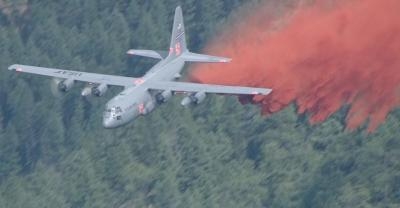Fri, Jun 28, 2013
MAFFs Aircraft Conduct 18 Sorties Tuesday In The Effort
More than 50,000 gallons of fire retardant was dropped by Air Force aerial firefighting aircraft June 25 on wildland fires burning throughout Colorado's West Fork Complex. Modular Airborne Fire Fighting System-equipped C-130s from both the Air Force Reserve and Air National Guard performed 18 drops against the wildfires, releasing 52,650 gallons along mountain ridgelines and near homes throughout affected residential areas. The U.S. Forest Service directed all MAFFS support to the West Fork Complex for June 25, an area encompassing the Windy Pass, West Fork, and Papoose fires.

According to USFS officials, the West Fork Complex fires had grown to 81,331 acres with zero percent containment as of 0930 local time June 26. Flying over the fire-ravaged areas, Lt. Col. Luke Thompson, 302nd AW chief of aerial firefighting and certified MAFFS C-130 instructor pilot, said a number of retardant drops on the West Fork Complex fires were "very tight" as MAFFS aircraft dropped between homes and encroaching flames.
As we use ridge tops and canyons, we try to draw long lines to protect homes," Thompson said. "Down there, we've seen both light fire behavior and other areas erupting into big columns of flames with steep terrains and hot spots as well. These defensive lines are protecting structures."
At the request of the USFS, MAFFS aircraft and aircrews remain activated to provide support throughout the Rocky Mountain region. Since MAFFS aircraft first provided support to the Black Forest fire June 12, more than 169,000 gallons of fire retardant have been dropped on Colorado wildfires. Both aircraft and Airmen from the AF Reserve's 302nd Airlift Wing and the 146th AW from the California ANG are providing MAFFS assistance to the USFS.
Thompson said after two weeks, crew morale still remains high. "Crews are still ready to launch against these fires. These have been long days, every day. But overall, morale with the crews is good."
The MAFFS units are owned by the U.S. Forest Service, one of several federal and state government agencies and organizations with roles and responsibilities in wildland fire suppression that comprise the National Interagency Fire Center based in Boise, ID. MAFFS is a self-contained aerial firefighting system that can discharge 3,000 gallons of water or fire retardant in less than five seconds, covering an area one-quarter of a mile long by 100 feet wide. Once the load is discharged, it can be refilled in less than 12 minutes.
ANN Salutes Tech. Sgt. Stephen J. Collier, 302nd Airlift Wing Public Affairs
(Image provided by the U.S. Air Force.)
More News
The Industry Continues to be Rocked By Some Questionable Operations Recent investigations and a great deal of data has resulted in ANN’s SportPlane Resource Guide’s rep>[...]
Make Sure You NEVER Miss A New Story From Aero-News Network Do you ever feel like you never see posts from a certain person or page on Facebook or Instagram? Here’s how you c>[...]
Visual Approach Slope Indicator (VASI) An airport lighting facility providing vertical visual approach slope guidance to aircraft during approach to landing by radiating a directio>[...]
Airport Marking Aids Markings used on runway and taxiway surfaces to identify a specific runway, a runway threshold, a centerline, a hold line, etc. A runway should be marked in ac>[...]
Aero Linx: The Skyhawk Association The Skyhawk Association is a non-profit organization founded by former Skyhawk Pilots which is open to anyone with an affinity for the A-4 Skyhaw>[...]
 Unfortunate... ANN/SportPlane Resource Guide Adds To Cautionary Advisories
Unfortunate... ANN/SportPlane Resource Guide Adds To Cautionary Advisories ANN FAQ: Turn On Post Notifications
ANN FAQ: Turn On Post Notifications ANN's Daily Aero-Term (04.29.24): Visual Approach Slope Indicator (VASI)
ANN's Daily Aero-Term (04.29.24): Visual Approach Slope Indicator (VASI) ANN's Daily Aero-Term (04.28.24): Airport Marking Aids
ANN's Daily Aero-Term (04.28.24): Airport Marking Aids ANN's Daily Aero-Linx (04.28.24)
ANN's Daily Aero-Linx (04.28.24)



